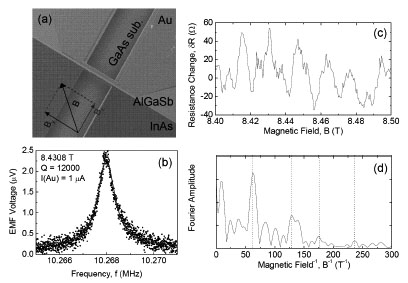Imran Mahboob and Hiroshi Yamaguchi
Physical Science Laboratory
In this study, modulations in the phase of the electron wave function were used to detect the miniscule displacements of the mechanical element [1]. A quasi-1D diffusive electron system in an InAs quantum well was incorporated onto an AlGaSb nano-mechanical suspended beam and is shown in Fig.1(a). Additionally, a Au wire was also placed on the suspended beam to enable the mechanical resonance to be actuated via the magnetomotive method where an alternating current was passed in the Au channel in the presence of a magnetic field. An out of plane beam resonance frequency, f0 = 10.268 MHz and quality factor, Q = 12500 was measured at 20 mK and is shown in Fig.1(b).
The beam oscillation was then detected by measuring the resistance change in the quasi-1D electron system as a function of beam vibration frequency and magnetic field. The resistance change at the beam resonance frequency (magnetopiezoresistance [MPR]) was strongly peaked. By varying the magnetic field, this resistance change at resonance could be modulated. The MPR at mechanical resonance showed reproducible highly periodic resistance oscillations which arise via strain induced electron phase modulation and is shown in Fig.1(c). The Fourier transform of the MPR [shown in Fig.1(d)] indicates that mechanical activation of the beam affects only a few electron trajectories and the electron interference in only a single electron loop gives rise to the resistance oscillations observed in the MPR.
[1] I. Mahboob, et al., Appl. Phys. Lett. 89 (2006) 192106.
 |
||
|